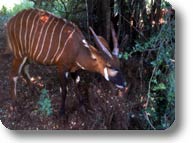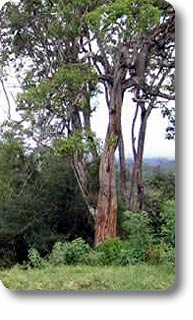|
Points of Interest
|
|
Wildlife
|




|
Among the 2,000 elephants that roam the clouded hills and misty glades, are the few remaining habitats of the elusive rare Bongo antelope and the rare giant forest hog. Black rhinos are also present in the Park.
Amidst forests and moorlands, large herds of Cape buffalo browse, while the forest depths provide sanctuary for the dainty blue duiker and bushbuck as primate troops of colobus, sykes and the black-faced vervet rustle through the trees and lush stands of bamboo. Sombre olive baboon patrol the forests and grasslands, fearfully avoiding the leopard!
Among the other carnivores, there are the African wild cat, the spotted hyena, the African civet and the rare golden cat. More often heard than seen, lions were introduced in the Park some years ago.
Also rarely seen are serval cats, with many being melanistic (black) due to their adaptation to this higher altitude. Tumbling mountain streams are home to the African clawless otter, which compete with anglers in pursuit of brown and rainbow trout.
Birds
Abundant Aberdare birdlife greets most dawns as a chorus of birdsong pours out of the forests. Over 290 species have been recorded, including the Aberdare Cisticola - that is critically endangered - and the Jackson's Francolin, which is regionally endemic. Often encountered are the bold Silvery-cheeked Hornbill with their raucous cry and casqued beaks, as well as the scarlet-winged flash of the Hartlaub's Turaco. Plentiful birds of prey include Augur Buzzard, African Goshawk, Hawk Eagle and the magnificent African Crowned Eagle, which preyS on monkey, francolin and guinea fowl.
Within forest glades are the cinnamon-chested Bee-eater and African Paradise Flycatcher, while the bamboo glades or higher moorlands are the domain of numerous species. |
Reptiles
|
The Aberdare forests are home to a large number of snakes, frogs and lizards.
Snakes of interest feature the montane egg-eater, a slender bird egg lover, the Kenyan striped skaapsteker, a resident of the high grasslands of the Kinangop Plateau and the endemic Kenya montane viper, found at high altitude of the Aberdares and Mt. Kenya.
The broad array of lizards includes the striped skink, the alpine-meadow skink, the variable skink and the grass-top skink which can often be seen wriggling through tussock grass clumps. |
|
Insects
|
 |
The Park shelters more insects than any other living creature!
Common around most forest lodges are large noisy carpenter bees while both forests and moorlands are exceptionally rich in butterflies such as the striking large swallowtails and the endemic highland forest blue charaxes, the white-barred charaxes and the black-bordered charaxes, while the lively little painted ringlet is restricted to the bamboo zone. |
Plants
|
| The forests of the Aberdare range are globally renowned for their botanical richness. At varying altitudes are a wealth of flora: from the top while descending, alpine and sub-alpine species such as senecio, lobelia, Erica helichrysum and tussock grass give way to bamboo and mountain woodlands, mainly junipers Podocarpus and Nuxia congesta forest on the western and north-western slopes. Ocotea forests are found on the southeast, while mixed Podocarpus forest in the east and on Kipipiri. Pockets of hagenia forest also occur in sheltered patches on the rolling moorlands. |

